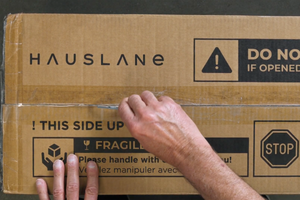What Size Range Hood Fits My Kitchen?
Kitchen range hoods aren't just another appliance; they are a critical component of kitchen design and functionality. Serving not only to vent grease, smoke, and odors but also to contribute to the overall safety and cleanliness of your cooking space, the importance of a well-chosen range hood cannot be overstated. This piece of equipment ensures that your kitchen remains a comfortable and healthy place to create meals.

What Size Range Hood Do I Need for My Kitchen?
Choosing the right size range hood is crucial for effective kitchen ventilation. The size of your kitchen and the width of your stove play pivotal roles in determining the appropriate dimensions for your range hood. For instance, Hauslane is a renowned brand in the kitchen appliance industry, known for its innovative designs and reliable products. They offer a versatile range of hood sizes to accommodate various kitchen dimensions and consumer needs. For standard kitchen setups, Hauslane provides 30-inch and 36-inch models, ensuring a perfect fit for most traditional spaces. For larger or more customized kitchen arrangements, their big hood options include sizes of 34, 40, 42, and 46 inches, catering to more expansive cooking areas that require greater ventilation capacity.
Understanding the Relationship Between Stove Size and Hood Width
It is advisable for the range hood to extend at least 3 inches beyond the stove top on each side. This ensures adequate capture of smoke, steam, and airborne grease, improving the air quality and cleanliness of your kitchen.
Calculating the Necessary CFM for Your Range Hood
The cubic feet per minute (CFM) of a range hood indicates its air-exhausting power. The formula for determining your kitchen's CFM requirements varies based on stove type and kitchen size, but generally, a higher CFM is recommended for larger ranges and more frequent cooking.

Types of Range Hoods
Range hoods come in various designs, each suitable for different kitchen layouts.
- Under-cabinet hoods: These are installed beneath the kitchen cabinet above your stove. They are compact and efficient, especially in kitchens with limited space.
- Wall-mount hoods: Installed against the kitchen wall, these hoods are prominent in kitchens where the stove is located along the kitchen wall.
- Island hoods: Designed for stoves built into a center island, these hoods hang from the ceiling and are a focal point in open-concept kitchens.
- Downdraft hoods: These innovative hoods pull air downward, are ideal for minimalist kitchens, and are often used with island stoves.
- Grease hoods: Designed to vent grease, smoke, and other particulate matter, these are commonly used in commercial kitchens. They are typically installed over fryers, grills, broilers, and stoves, and are a staple of any commercial restaurant equipment setup.
Which Type of Range Hood is Best for Your Kitchen Layout?
Choosing the right type of range hood depends on your kitchen’s layout and the placement of your stove. Each type offers distinct advantages in functionality and aesthetic integration.
Features to Consider When Choosing a Range Hood
Selecting a range hood involves more than just measuring dimensions and CFM; you also need to consider features that enhance usability and efficiency.
Importance of Adjustable Fan Speeds and Why
Adjustable speeds are crucial for accommodating different cooking styles, from simmering sauces to searing meats, ensuring that ventilation is both effective and energy-efficient.
The Advantages of Range Hoods with Built-in Lighting
Built-in lighting in range hoods isn’t just functional; it also enhances the overall ambiance of the kitchen, making it easier to monitor cooking progress and adding to the aesthetics of the space.
Shop Powerful Range Hoods
From HAUSLANE
How to Install a Range Hood
Installing a range hood involves several steps that vary slightly depending on the type of hood.
Tools and Materials Needed for Installation
Essential tools and materials include:
Step-by-Step Installation Guide
The installation process typically involves securing the hood to the wall or ceiling, connecting ductwork, and ensuring electrical connections are safe and compliant with local codes.
Precautions to Take During Installation
Safety is paramount when installing a range hood. Ensure that all electrical connections are turned off during installation, and consider professional help for complex setups.

Maintaining Your Range Hood
Regular maintenance is essential to keep your range hood operating efficiently.
How Often Should You Clean Your Range Hood?
The frequency of cleaning depends on how much you cook and what types of foods you prepare. Frequent cooking, especially with oils and spices, necessitates more regular maintenance.
Common Issues with Range Hoods and Troubleshooting
Even well-maintained range hoods can encounter problems.
What to Do if Your Range Hood Isn't Venting Properly
Check for blockages, ensure the filter is clean, and consider if increased CFM might be necessary.
Solutions for Excessive Noise from Your Range Hood
Investigating the cause of noise can help, whether it's loose components or a need for fan adjustments. Professional help may be required for more complex issues.
Conclusion
Choosing the right size and type of range hood for your kitchen is crucial for maintaining a pleasant and safe cooking environment. By understanding the specific requirements based on your kitchen's layout and your cooking habits, you can select a range hood that not only functions effectively but also enhances the style of your home.








